Comprehensive Report: Community-Based Health in Denton County, Texas
VerifiedAdded on 2022/09/10
|8
|1891
|14
Report
AI Summary
This report provides a comprehensive overview of community-based health in Denton County, Texas. It begins with a demographic and health information section, detailing the county's population, growth rate, and key health indicators, including lower rates of premature deaths and a relatively healthy population compared to other Texas counties. The report highlights significant health-related issues such as accessibility to proper care, cancer, and obesity treatment, particularly focusing on challenges like inadequate prenatal care, high rates of overweight and obesity, and the increasing elderly population facing chronic diseases. The report then examines consumer health perspectives, listing community resources like the National Cancer Institute and the CDC, alongside recommended community strategies and measurements to prevent obesity and improve cancer patient outcomes. Public health perspectives are also discussed, including intervention measures like behavioral strategies, dietary changes, and healthcare improvements. Finally, the report includes references to relevant articles that support the findings and recommendations, emphasizing the importance of health intervention and prevention strategies.
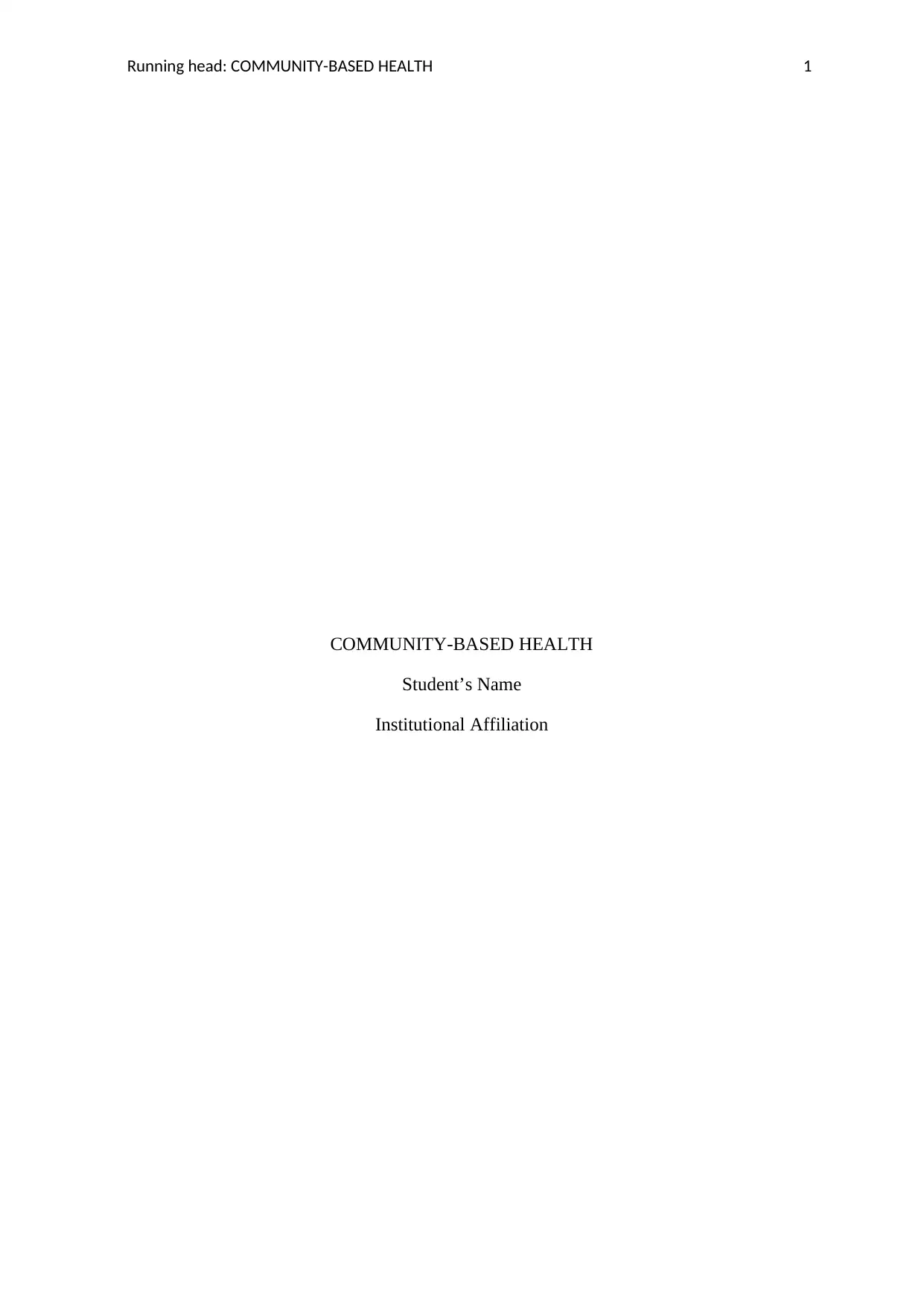
Running head: COMMUNITY-BASED HEALTH 1
COMMUNITY-BASED HEALTH
Student’s Name
Institutional Affiliation
COMMUNITY-BASED HEALTH
Student’s Name
Institutional Affiliation
Paraphrase This Document
Need a fresh take? Get an instant paraphrase of this document with our AI Paraphraser
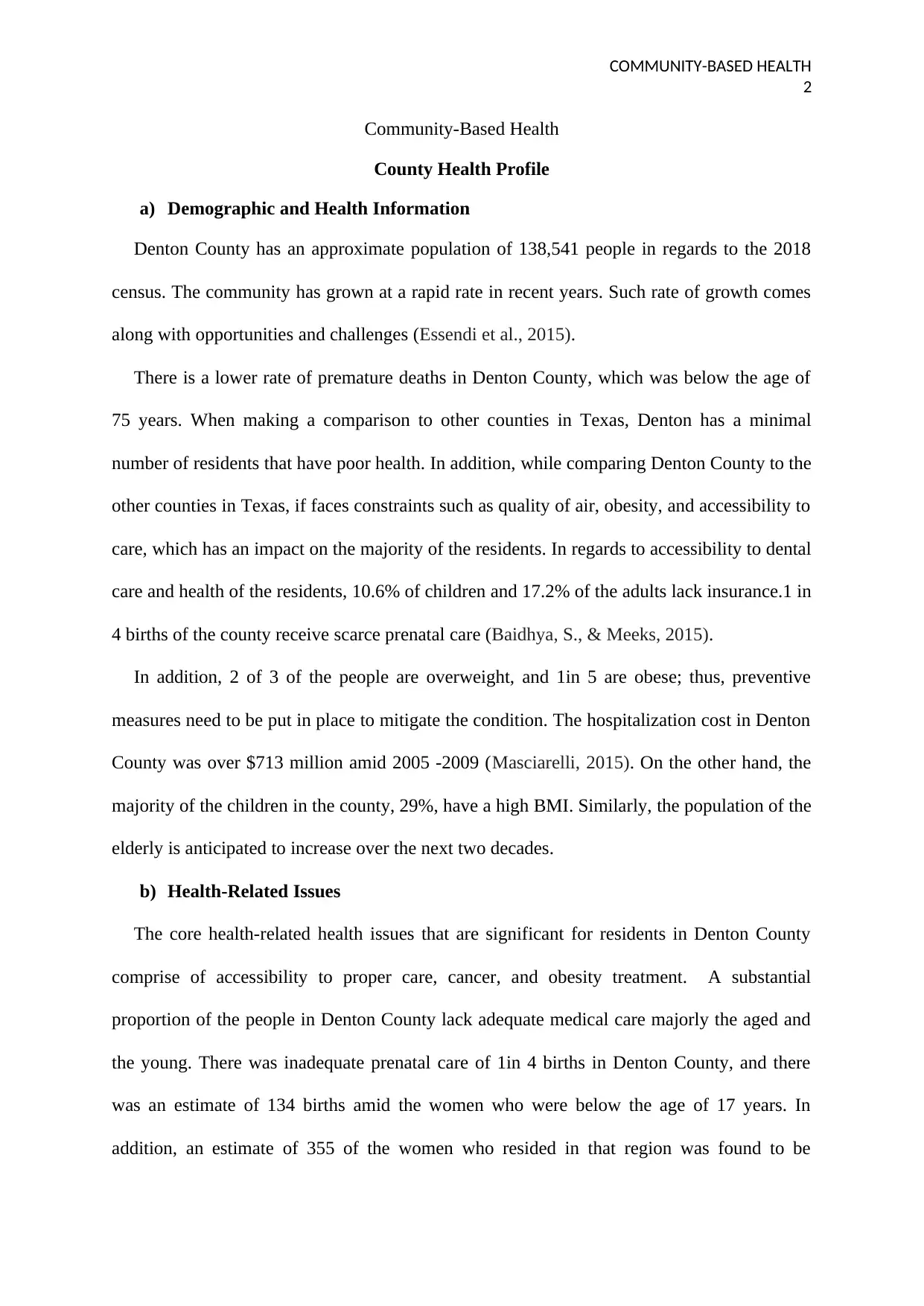
COMMUNITY-BASED HEALTH
2
Community-Based Health
County Health Profile
a) Demographic and Health Information
Denton County has an approximate population of 138,541 people in regards to the 2018
census. The community has grown at a rapid rate in recent years. Such rate of growth comes
along with opportunities and challenges (Essendi et al., 2015).
There is a lower rate of premature deaths in Denton County, which was below the age of
75 years. When making a comparison to other counties in Texas, Denton has a minimal
number of residents that have poor health. In addition, while comparing Denton County to the
other counties in Texas, if faces constraints such as quality of air, obesity, and accessibility to
care, which has an impact on the majority of the residents. In regards to accessibility to dental
care and health of the residents, 10.6% of children and 17.2% of the adults lack insurance.1 in
4 births of the county receive scarce prenatal care (Baidhya, S., & Meeks, 2015).
In addition, 2 of 3 of the people are overweight, and 1in 5 are obese; thus, preventive
measures need to be put in place to mitigate the condition. The hospitalization cost in Denton
County was over $713 million amid 2005 -2009 (Masciarelli, 2015). On the other hand, the
majority of the children in the county, 29%, have a high BMI. Similarly, the population of the
elderly is anticipated to increase over the next two decades.
b) Health-Related Issues
The core health-related health issues that are significant for residents in Denton County
comprise of accessibility to proper care, cancer, and obesity treatment. A substantial
proportion of the people in Denton County lack adequate medical care majorly the aged and
the young. There was inadequate prenatal care of 1in 4 births in Denton County, and there
was an estimate of 134 births amid the women who were below the age of 17 years. In
addition, an estimate of 355 of the women who resided in that region was found to be
2
Community-Based Health
County Health Profile
a) Demographic and Health Information
Denton County has an approximate population of 138,541 people in regards to the 2018
census. The community has grown at a rapid rate in recent years. Such rate of growth comes
along with opportunities and challenges (Essendi et al., 2015).
There is a lower rate of premature deaths in Denton County, which was below the age of
75 years. When making a comparison to other counties in Texas, Denton has a minimal
number of residents that have poor health. In addition, while comparing Denton County to the
other counties in Texas, if faces constraints such as quality of air, obesity, and accessibility to
care, which has an impact on the majority of the residents. In regards to accessibility to dental
care and health of the residents, 10.6% of children and 17.2% of the adults lack insurance.1 in
4 births of the county receive scarce prenatal care (Baidhya, S., & Meeks, 2015).
In addition, 2 of 3 of the people are overweight, and 1in 5 are obese; thus, preventive
measures need to be put in place to mitigate the condition. The hospitalization cost in Denton
County was over $713 million amid 2005 -2009 (Masciarelli, 2015). On the other hand, the
majority of the children in the county, 29%, have a high BMI. Similarly, the population of the
elderly is anticipated to increase over the next two decades.
b) Health-Related Issues
The core health-related health issues that are significant for residents in Denton County
comprise of accessibility to proper care, cancer, and obesity treatment. A substantial
proportion of the people in Denton County lack adequate medical care majorly the aged and
the young. There was inadequate prenatal care of 1in 4 births in Denton County, and there
was an estimate of 134 births amid the women who were below the age of 17 years. In
addition, an estimate of 355 of the women who resided in that region was found to be
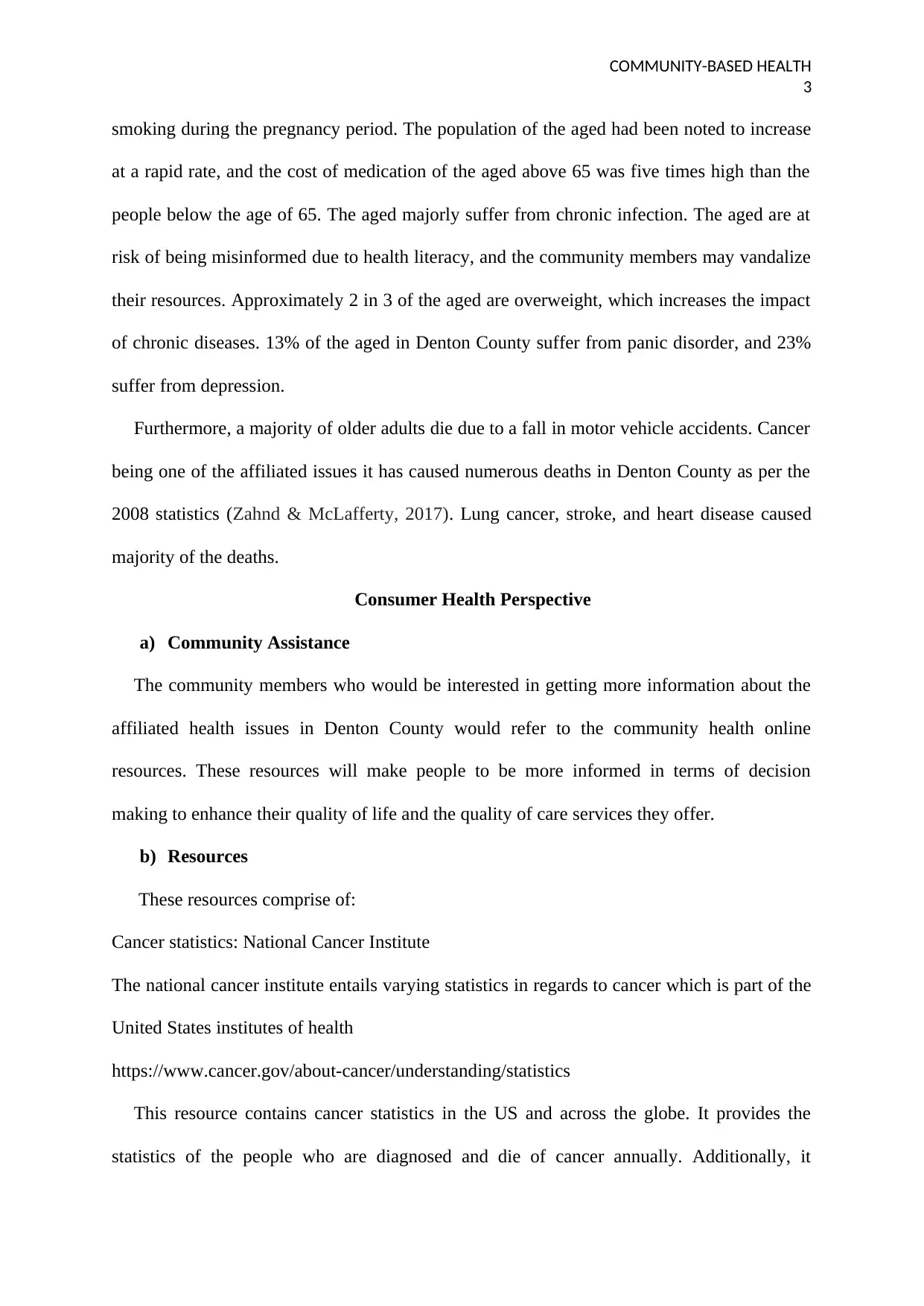
COMMUNITY-BASED HEALTH
3
smoking during the pregnancy period. The population of the aged had been noted to increase
at a rapid rate, and the cost of medication of the aged above 65 was five times high than the
people below the age of 65. The aged majorly suffer from chronic infection. The aged are at
risk of being misinformed due to health literacy, and the community members may vandalize
their resources. Approximately 2 in 3 of the aged are overweight, which increases the impact
of chronic diseases. 13% of the aged in Denton County suffer from panic disorder, and 23%
suffer from depression.
Furthermore, a majority of older adults die due to a fall in motor vehicle accidents. Cancer
being one of the affiliated issues it has caused numerous deaths in Denton County as per the
2008 statistics (Zahnd & McLafferty, 2017). Lung cancer, stroke, and heart disease caused
majority of the deaths.
Consumer Health Perspective
a) Community Assistance
The community members who would be interested in getting more information about the
affiliated health issues in Denton County would refer to the community health online
resources. These resources will make people to be more informed in terms of decision
making to enhance their quality of life and the quality of care services they offer.
b) Resources
These resources comprise of:
Cancer statistics: National Cancer Institute
The national cancer institute entails varying statistics in regards to cancer which is part of the
United States institutes of health
https://www.cancer.gov/about-cancer/understanding/statistics
This resource contains cancer statistics in the US and across the globe. It provides the
statistics of the people who are diagnosed and die of cancer annually. Additionally, it
3
smoking during the pregnancy period. The population of the aged had been noted to increase
at a rapid rate, and the cost of medication of the aged above 65 was five times high than the
people below the age of 65. The aged majorly suffer from chronic infection. The aged are at
risk of being misinformed due to health literacy, and the community members may vandalize
their resources. Approximately 2 in 3 of the aged are overweight, which increases the impact
of chronic diseases. 13% of the aged in Denton County suffer from panic disorder, and 23%
suffer from depression.
Furthermore, a majority of older adults die due to a fall in motor vehicle accidents. Cancer
being one of the affiliated issues it has caused numerous deaths in Denton County as per the
2008 statistics (Zahnd & McLafferty, 2017). Lung cancer, stroke, and heart disease caused
majority of the deaths.
Consumer Health Perspective
a) Community Assistance
The community members who would be interested in getting more information about the
affiliated health issues in Denton County would refer to the community health online
resources. These resources will make people to be more informed in terms of decision
making to enhance their quality of life and the quality of care services they offer.
b) Resources
These resources comprise of:
Cancer statistics: National Cancer Institute
The national cancer institute entails varying statistics in regards to cancer which is part of the
United States institutes of health
https://www.cancer.gov/about-cancer/understanding/statistics
This resource contains cancer statistics in the US and across the globe. It provides the
statistics of the people who are diagnosed and die of cancer annually. Additionally, it
You're viewing a preview
Unlock full access by subscribing today!
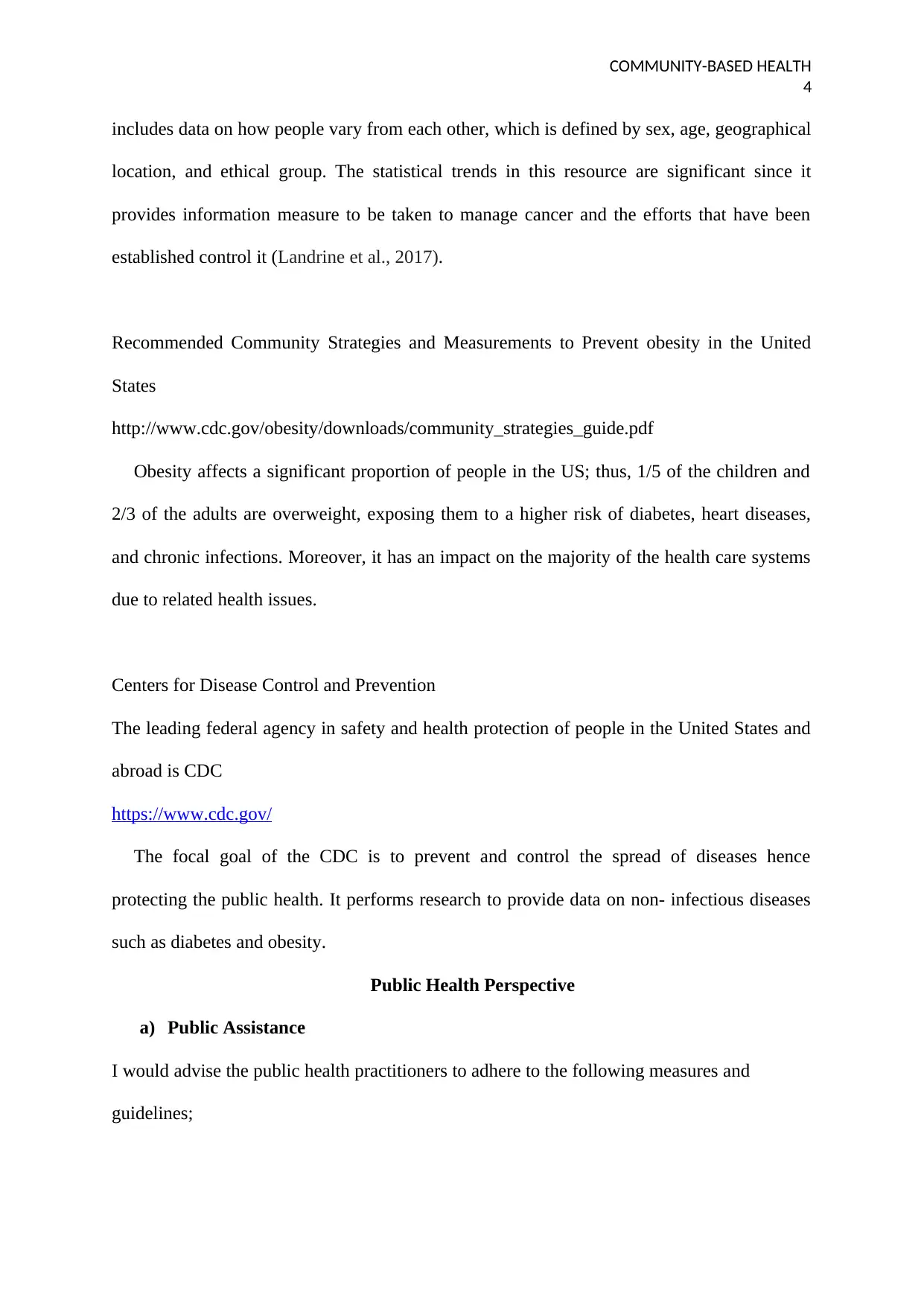
COMMUNITY-BASED HEALTH
4
includes data on how people vary from each other, which is defined by sex, age, geographical
location, and ethical group. The statistical trends in this resource are significant since it
provides information measure to be taken to manage cancer and the efforts that have been
established control it (Landrine et al., 2017).
Recommended Community Strategies and Measurements to Prevent obesity in the United
States
http://www.cdc.gov/obesity/downloads/community_strategies_guide.pdf
Obesity affects a significant proportion of people in the US; thus, 1/5 of the children and
2/3 of the adults are overweight, exposing them to a higher risk of diabetes, heart diseases,
and chronic infections. Moreover, it has an impact on the majority of the health care systems
due to related health issues.
Centers for Disease Control and Prevention
The leading federal agency in safety and health protection of people in the United States and
abroad is CDC
https://www.cdc.gov/
The focal goal of the CDC is to prevent and control the spread of diseases hence
protecting the public health. It performs research to provide data on non- infectious diseases
such as diabetes and obesity.
Public Health Perspective
a) Public Assistance
I would advise the public health practitioners to adhere to the following measures and
guidelines;
4
includes data on how people vary from each other, which is defined by sex, age, geographical
location, and ethical group. The statistical trends in this resource are significant since it
provides information measure to be taken to manage cancer and the efforts that have been
established control it (Landrine et al., 2017).
Recommended Community Strategies and Measurements to Prevent obesity in the United
States
http://www.cdc.gov/obesity/downloads/community_strategies_guide.pdf
Obesity affects a significant proportion of people in the US; thus, 1/5 of the children and
2/3 of the adults are overweight, exposing them to a higher risk of diabetes, heart diseases,
and chronic infections. Moreover, it has an impact on the majority of the health care systems
due to related health issues.
Centers for Disease Control and Prevention
The leading federal agency in safety and health protection of people in the United States and
abroad is CDC
https://www.cdc.gov/
The focal goal of the CDC is to prevent and control the spread of diseases hence
protecting the public health. It performs research to provide data on non- infectious diseases
such as diabetes and obesity.
Public Health Perspective
a) Public Assistance
I would advise the public health practitioners to adhere to the following measures and
guidelines;
Paraphrase This Document
Need a fresh take? Get an instant paraphrase of this document with our AI Paraphraser
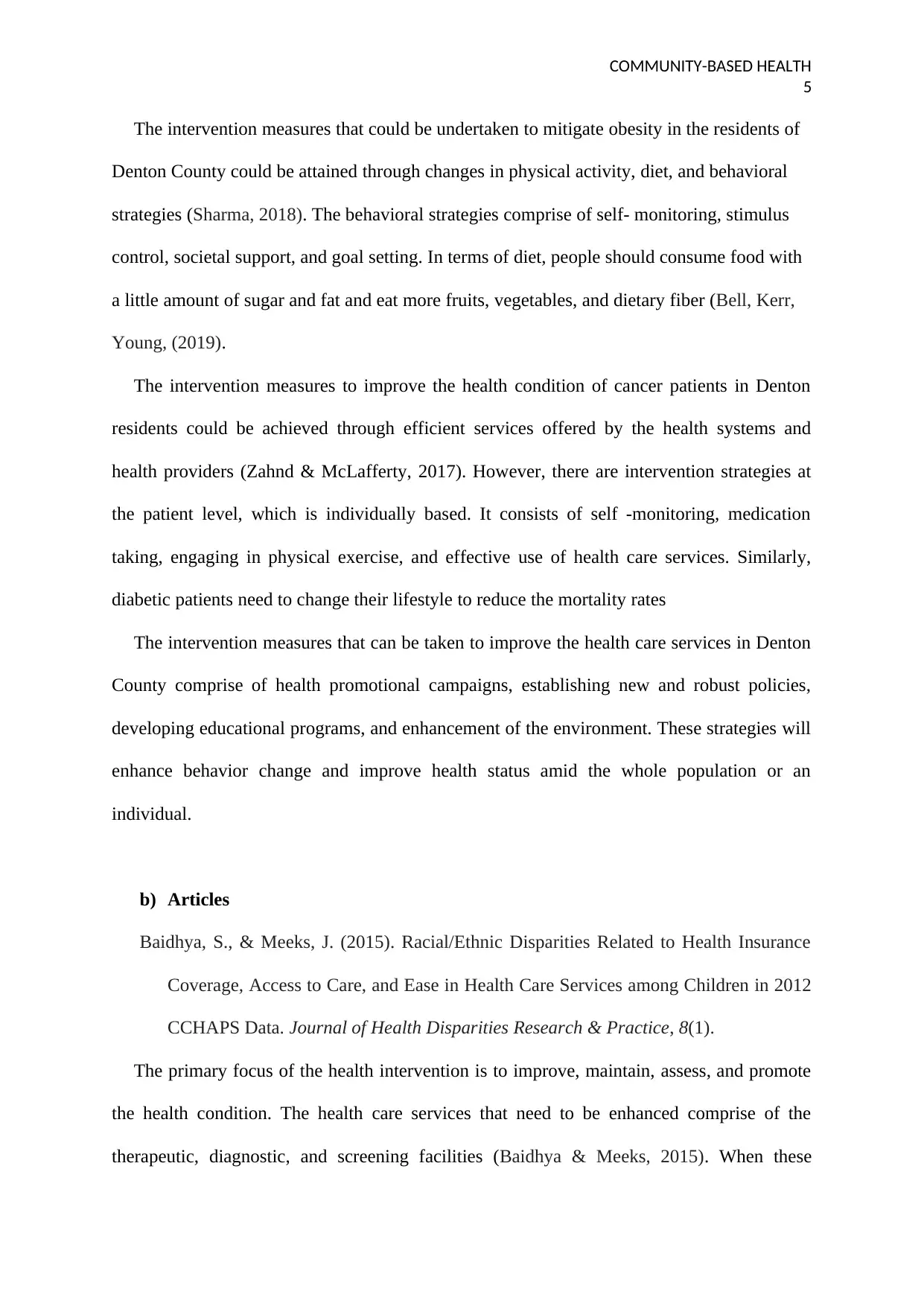
COMMUNITY-BASED HEALTH
5
The intervention measures that could be undertaken to mitigate obesity in the residents of
Denton County could be attained through changes in physical activity, diet, and behavioral
strategies (Sharma, 2018). The behavioral strategies comprise of self- monitoring, stimulus
control, societal support, and goal setting. In terms of diet, people should consume food with
a little amount of sugar and fat and eat more fruits, vegetables, and dietary fiber (Bell, Kerr,
Young, (2019).
The intervention measures to improve the health condition of cancer patients in Denton
residents could be achieved through efficient services offered by the health systems and
health providers (Zahnd & McLafferty, 2017). However, there are intervention strategies at
the patient level, which is individually based. It consists of self -monitoring, medication
taking, engaging in physical exercise, and effective use of health care services. Similarly,
diabetic patients need to change their lifestyle to reduce the mortality rates
The intervention measures that can be taken to improve the health care services in Denton
County comprise of health promotional campaigns, establishing new and robust policies,
developing educational programs, and enhancement of the environment. These strategies will
enhance behavior change and improve health status amid the whole population or an
individual.
b) Articles
Baidhya, S., & Meeks, J. (2015). Racial/Ethnic Disparities Related to Health Insurance
Coverage, Access to Care, and Ease in Health Care Services among Children in 2012
CCHAPS Data. Journal of Health Disparities Research & Practice, 8(1).
The primary focus of the health intervention is to improve, maintain, assess, and promote
the health condition. The health care services that need to be enhanced comprise of the
therapeutic, diagnostic, and screening facilities (Baidhya & Meeks, 2015). When these
5
The intervention measures that could be undertaken to mitigate obesity in the residents of
Denton County could be attained through changes in physical activity, diet, and behavioral
strategies (Sharma, 2018). The behavioral strategies comprise of self- monitoring, stimulus
control, societal support, and goal setting. In terms of diet, people should consume food with
a little amount of sugar and fat and eat more fruits, vegetables, and dietary fiber (Bell, Kerr,
Young, (2019).
The intervention measures to improve the health condition of cancer patients in Denton
residents could be achieved through efficient services offered by the health systems and
health providers (Zahnd & McLafferty, 2017). However, there are intervention strategies at
the patient level, which is individually based. It consists of self -monitoring, medication
taking, engaging in physical exercise, and effective use of health care services. Similarly,
diabetic patients need to change their lifestyle to reduce the mortality rates
The intervention measures that can be taken to improve the health care services in Denton
County comprise of health promotional campaigns, establishing new and robust policies,
developing educational programs, and enhancement of the environment. These strategies will
enhance behavior change and improve health status amid the whole population or an
individual.
b) Articles
Baidhya, S., & Meeks, J. (2015). Racial/Ethnic Disparities Related to Health Insurance
Coverage, Access to Care, and Ease in Health Care Services among Children in 2012
CCHAPS Data. Journal of Health Disparities Research & Practice, 8(1).
The primary focus of the health intervention is to improve, maintain, assess, and promote
the health condition. The health care services that need to be enhanced comprise of the
therapeutic, diagnostic, and screening facilities (Baidhya & Meeks, 2015). When these
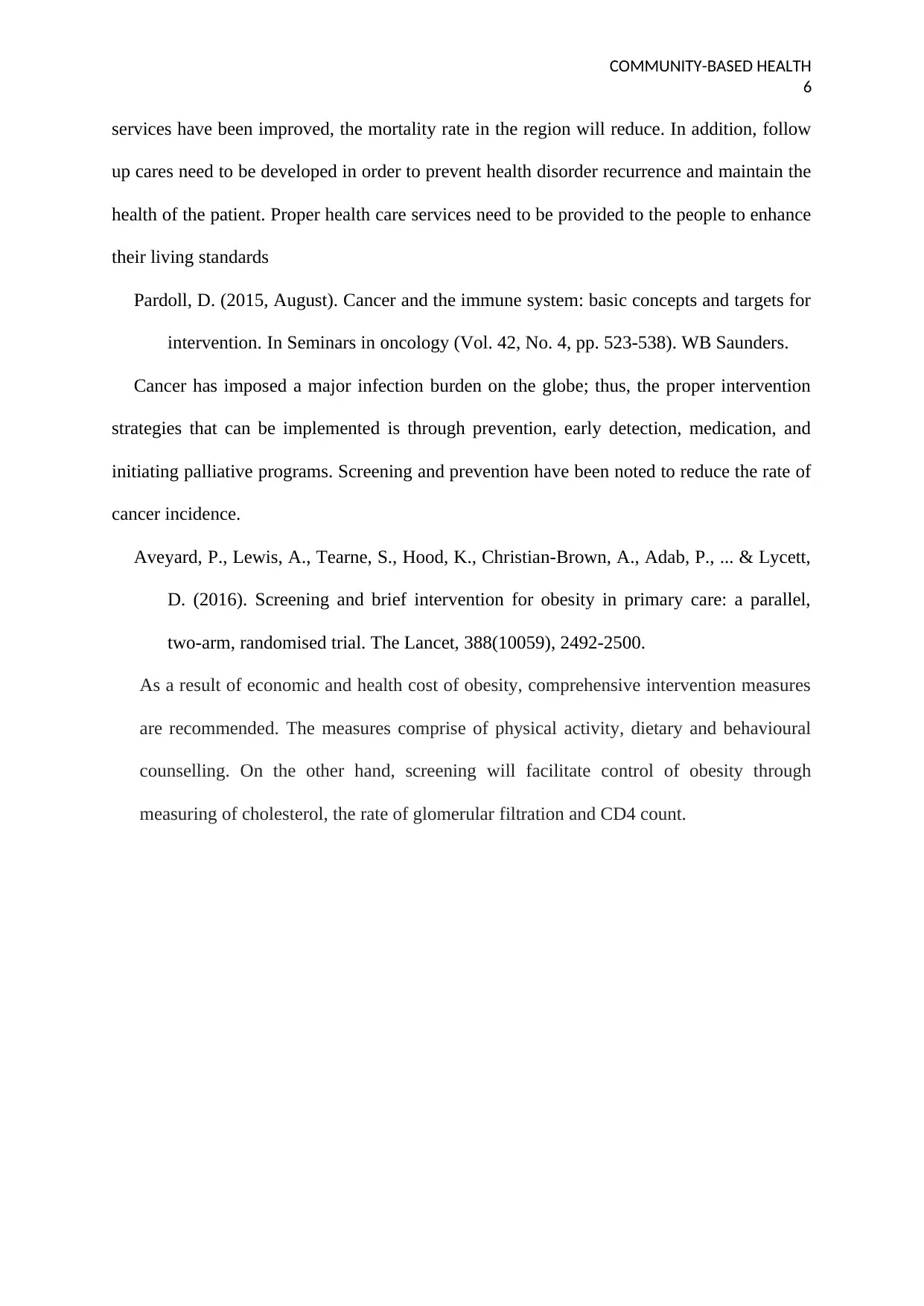
COMMUNITY-BASED HEALTH
6
services have been improved, the mortality rate in the region will reduce. In addition, follow
up cares need to be developed in order to prevent health disorder recurrence and maintain the
health of the patient. Proper health care services need to be provided to the people to enhance
their living standards
Pardoll, D. (2015, August). Cancer and the immune system: basic concepts and targets for
intervention. In Seminars in oncology (Vol. 42, No. 4, pp. 523-538). WB Saunders.
Cancer has imposed a major infection burden on the globe; thus, the proper intervention
strategies that can be implemented is through prevention, early detection, medication, and
initiating palliative programs. Screening and prevention have been noted to reduce the rate of
cancer incidence.
Aveyard, P., Lewis, A., Tearne, S., Hood, K., Christian-Brown, A., Adab, P., ... & Lycett,
D. (2016). Screening and brief intervention for obesity in primary care: a parallel,
two-arm, randomised trial. The Lancet, 388(10059), 2492-2500.
As a result of economic and health cost of obesity, comprehensive intervention measures
are recommended. The measures comprise of physical activity, dietary and behavioural
counselling. On the other hand, screening will facilitate control of obesity through
measuring of cholesterol, the rate of glomerular filtration and CD4 count.
6
services have been improved, the mortality rate in the region will reduce. In addition, follow
up cares need to be developed in order to prevent health disorder recurrence and maintain the
health of the patient. Proper health care services need to be provided to the people to enhance
their living standards
Pardoll, D. (2015, August). Cancer and the immune system: basic concepts and targets for
intervention. In Seminars in oncology (Vol. 42, No. 4, pp. 523-538). WB Saunders.
Cancer has imposed a major infection burden on the globe; thus, the proper intervention
strategies that can be implemented is through prevention, early detection, medication, and
initiating palliative programs. Screening and prevention have been noted to reduce the rate of
cancer incidence.
Aveyard, P., Lewis, A., Tearne, S., Hood, K., Christian-Brown, A., Adab, P., ... & Lycett,
D. (2016). Screening and brief intervention for obesity in primary care: a parallel,
two-arm, randomised trial. The Lancet, 388(10059), 2492-2500.
As a result of economic and health cost of obesity, comprehensive intervention measures
are recommended. The measures comprise of physical activity, dietary and behavioural
counselling. On the other hand, screening will facilitate control of obesity through
measuring of cholesterol, the rate of glomerular filtration and CD4 count.
You're viewing a preview
Unlock full access by subscribing today!
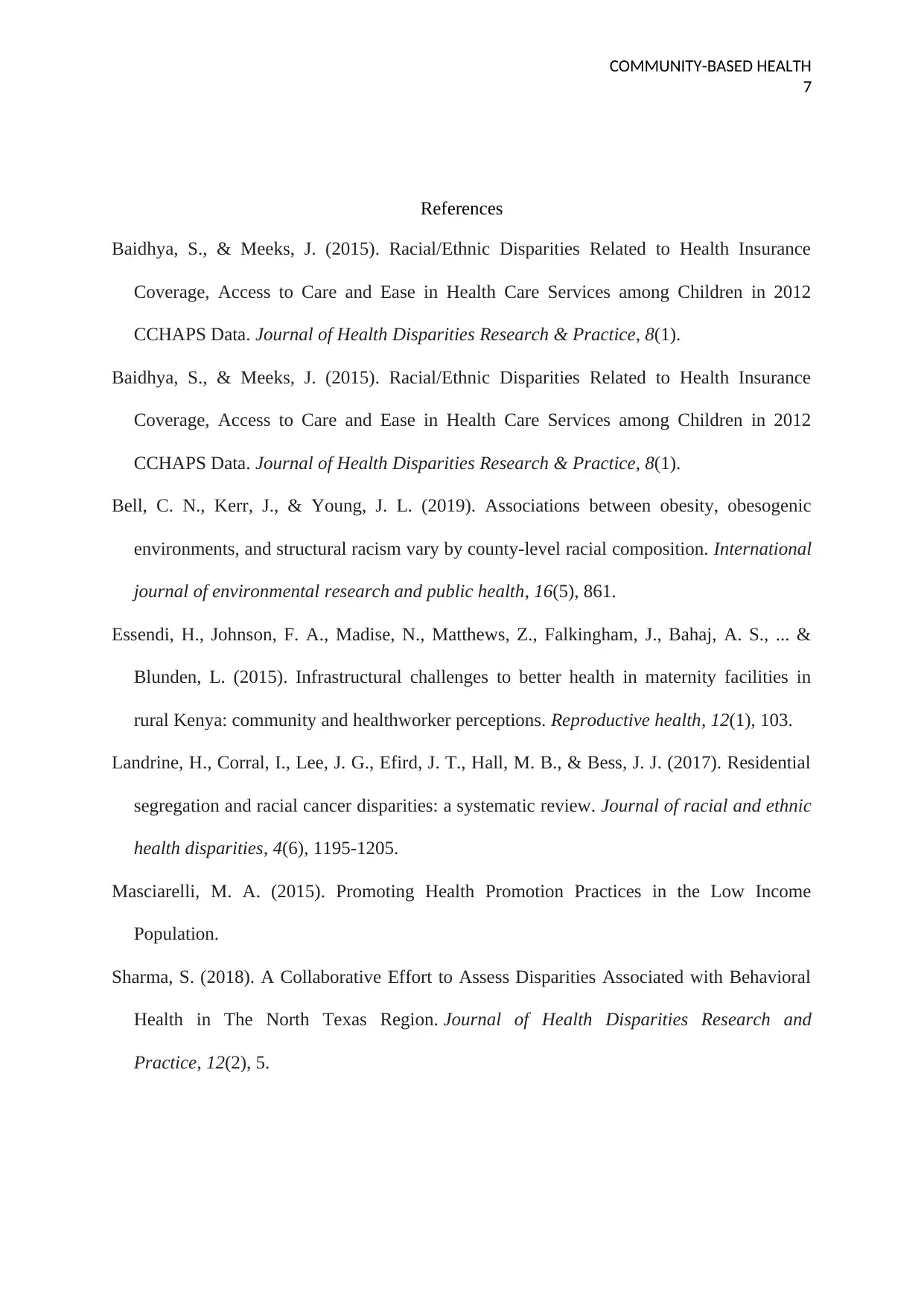
COMMUNITY-BASED HEALTH
7
References
Baidhya, S., & Meeks, J. (2015). Racial/Ethnic Disparities Related to Health Insurance
Coverage, Access to Care and Ease in Health Care Services among Children in 2012
CCHAPS Data. Journal of Health Disparities Research & Practice, 8(1).
Baidhya, S., & Meeks, J. (2015). Racial/Ethnic Disparities Related to Health Insurance
Coverage, Access to Care and Ease in Health Care Services among Children in 2012
CCHAPS Data. Journal of Health Disparities Research & Practice, 8(1).
Bell, C. N., Kerr, J., & Young, J. L. (2019). Associations between obesity, obesogenic
environments, and structural racism vary by county-level racial composition. International
journal of environmental research and public health, 16(5), 861.
Essendi, H., Johnson, F. A., Madise, N., Matthews, Z., Falkingham, J., Bahaj, A. S., ... &
Blunden, L. (2015). Infrastructural challenges to better health in maternity facilities in
rural Kenya: community and healthworker perceptions. Reproductive health, 12(1), 103.
Landrine, H., Corral, I., Lee, J. G., Efird, J. T., Hall, M. B., & Bess, J. J. (2017). Residential
segregation and racial cancer disparities: a systematic review. Journal of racial and ethnic
health disparities, 4(6), 1195-1205.
Masciarelli, M. A. (2015). Promoting Health Promotion Practices in the Low Income
Population.
Sharma, S. (2018). A Collaborative Effort to Assess Disparities Associated with Behavioral
Health in The North Texas Region. Journal of Health Disparities Research and
Practice, 12(2), 5.
7
References
Baidhya, S., & Meeks, J. (2015). Racial/Ethnic Disparities Related to Health Insurance
Coverage, Access to Care and Ease in Health Care Services among Children in 2012
CCHAPS Data. Journal of Health Disparities Research & Practice, 8(1).
Baidhya, S., & Meeks, J. (2015). Racial/Ethnic Disparities Related to Health Insurance
Coverage, Access to Care and Ease in Health Care Services among Children in 2012
CCHAPS Data. Journal of Health Disparities Research & Practice, 8(1).
Bell, C. N., Kerr, J., & Young, J. L. (2019). Associations between obesity, obesogenic
environments, and structural racism vary by county-level racial composition. International
journal of environmental research and public health, 16(5), 861.
Essendi, H., Johnson, F. A., Madise, N., Matthews, Z., Falkingham, J., Bahaj, A. S., ... &
Blunden, L. (2015). Infrastructural challenges to better health in maternity facilities in
rural Kenya: community and healthworker perceptions. Reproductive health, 12(1), 103.
Landrine, H., Corral, I., Lee, J. G., Efird, J. T., Hall, M. B., & Bess, J. J. (2017). Residential
segregation and racial cancer disparities: a systematic review. Journal of racial and ethnic
health disparities, 4(6), 1195-1205.
Masciarelli, M. A. (2015). Promoting Health Promotion Practices in the Low Income
Population.
Sharma, S. (2018). A Collaborative Effort to Assess Disparities Associated with Behavioral
Health in The North Texas Region. Journal of Health Disparities Research and
Practice, 12(2), 5.
Paraphrase This Document
Need a fresh take? Get an instant paraphrase of this document with our AI Paraphraser

COMMUNITY-BASED HEALTH
8
Zahnd, W. E., & McLafferty, S. L. (2017). Contextual effects and cancer outcomes in the
United States: a systematic review of characteristics in multilevel analyses. Annals of
epidemiology, 27(11), 739-748.
8
Zahnd, W. E., & McLafferty, S. L. (2017). Contextual effects and cancer outcomes in the
United States: a systematic review of characteristics in multilevel analyses. Annals of
epidemiology, 27(11), 739-748.
1 out of 8
Related Documents
Your All-in-One AI-Powered Toolkit for Academic Success.
+13062052269
info@desklib.com
Available 24*7 on WhatsApp / Email
![[object Object]](/_next/static/media/star-bottom.7253800d.svg)
Unlock your academic potential
© 2024 | Zucol Services PVT LTD | All rights reserved.





